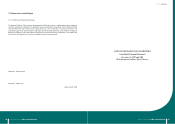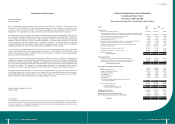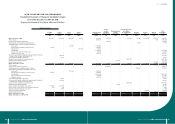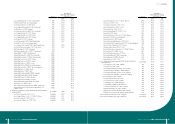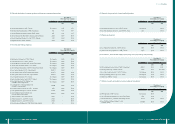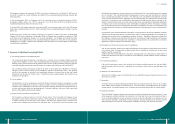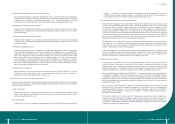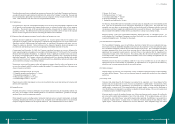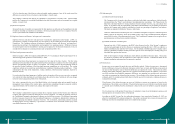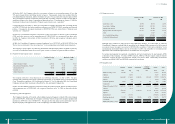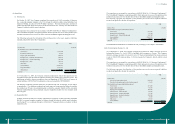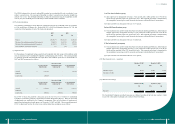Acer 2008 Annual Report Download - page 40
Download and view the complete annual report
Please find page 40 of the 2008 Acer annual report below. You can navigate through the pages in the report by either clicking on the pages listed below, or by using the keyword search tool below to find specific information within the annual report.
Acer Incorporated 2008 Annual Report76
Financial Standing
Acer Incorporated 2008 Annual Report 77
Unrealized gains and losses resulting from transactions between the Consolidated Companies and investees
accounted for under the equity method are deferred to the extent of the Company’s ownership. The gains and
losses resulting from depreciable or amortizable assets are recognized over the estimated useful lives of such
assets. Gains and losses from other assets are recognized when realized.
(12) Capital leases
For capital leases, where the Consolidated Companies act as the lessor, the Consolidated Companies account
for all periodic rental payments plus bargain purchase price or estimated residual value as lease payment
receivables. The present value of all lease payment receivables, discounted at the implicit interest rate, is
recorded as revenue. The difference between the lease payment receivables and the revenue is the unearned
interest revenue, recognized over the lease term using the effective interest method.
(13) Property, plant and equipment, property leased to others, and property not in use
Property, plant and equipment are stated at acquisition cost. Interest expense related to the purchase and
construction of property, plant and equipment is capitalized and included in the cost of the related asset.
Significant renewals, improvements and replacements are capitalized. Maintenance and repair costs are
charged to expense as incurred. Gains and losses on the disposal of property, plant and equipment are
recorded in the non-operating section in the accompanying consolidated statements of income.
Commencing from November 20, 2008, the Company capitalized retirement or recovery obligation for
newly acquired property and equipment in accordance with Interpretation (97) 340 issued by the Accounting
Research and Development Foundation. A component which is signicant in relation to the total cost of
the property and equipment and for which a different depreciation method or rate is appropriate should be
depreciated separately. The Company evaluates the estimated useful lives, depreciation method and residual
value at the end of each year. Changes in the estimated useful lives, depreciation method and residual value
are accounted for as changes in accounting estimates.
Depreciation is provided for property, plant and equipment, property leased to others, and property not in
use over the estimated useful life using the straight-line method. The estimated useful lives of the respective
classes of assets are as follows:
1. Buildings and improvements: 20~50 years
2. Computer equipment and machinery: 3~5 years
3. Transportation equipment: 3~5 years
4. Ofce and other equipment: 3~10 years
5. Leasehold improvement: 1~10 years
Property leased to others and property not in use are classied to other assets and continue to be depreciated
and tested for impairment.
(14) Intangible assets
Goodwill arising from a business combination was previously amortized using the straight-line method over
ve years. In accordance with the amended SFAS No. 25 “Business Combinations”, goodwill is no longer
amortized but is tested for impairment annually.
Other intangible assets, including patents, trademarks and trade names, customer relationships, developed
technology and purchased software, are stated at cost. Intangible assets with nite useful lives are amortized
using the straight-line method over the expected useful lives. The estimated useful lives are as follows:
1. Patents: 10~16 years
2. Purchased software: 3~7 years
3. Customer relationships: 7~10 years
4. Developed technology: 10 years
5. Trademarks and trade names: 20 years
The Gateway, Packard Bell and Eten trademarks and trade names are intangible assets with indenite useful
lives. They are not amortized, but are assessed for impairment on a yearly basis. The useful life of an
intangible asset not subject to amortization shall be reviewed each period to determine whether events and
circumstances continue to support an indenite useful life assessment for that asset. Any change in the useful
life assessment from indenite to nite shall be accounted for as a change in accounting estimate.
Effective January 1, 2007, the Consolidated Companies adopted SFAS No. 37 “Intangible Assets”. At
initial adoption, the Consolidated Companies reassessed the useful lives and amortization methods of the
recognized intangible assets. No change has been made.
(15) Non-nancial asset impairment
The Consolidated Companies assess at each balance sheet date whether there is any indication that long-
lived assets and certain identiable intangible assets may have been impaired. If any such indication exists,
the Consolidated Companies estimate the recoverable amount of the assets. The Consolidated Companies
recognize impairment loss for an asset whose carrying value is higher than the recoverable amount. An
impairment loss recognized in prior periods is reversed if there is any indication that the impairment loss
recognized no longer exists or has decreased. The carrying value after the reversal should not exceed the
recoverable amount or the depreciated or amortized balance of the assets assuming no impairment loss was
recognized in prior periods.
Goodwill and assets that have an indefinite useful life or are not yet available for use are not subject to
amortization and are tested annually for impairment. An impairment loss is recognized for the amount by
which the asset’s carrying amount exceeds its recoverable amount.
(16) Deferred charges
Deferred charges are stated at cost and primarily consist of additions and improvements to ofce buildings
and other deferred charges. These costs are amortized using the straight-line method over their estimated
useful lives.
(17) Treasury stock
Common stock repurchased by the Company is accounted for at acquisition cost. Upon disposal of the
treasury stock, the sale proceeds in excess of cost are accounted for as capital surplus ‒ treasury stock. If the
sale proceeds are less than cost, the deciency is accounted for as a reduction of the remaining balance of
capital surplus ‒ treasury stock. If the remaining balance of capital surplus ‒ treasury stock is insufcient to
cover the deciency, the remainder is recorded as a reduction of retained earnings. The cost of treasury stock
is computed using the weighted-average method.
If treasury stock is retired, the weighted-average cost of the retired treasury stock is written off to offset the
par value and the capital surplus premium, if any, of the stock retired. If the weighted-average cost written
off exceeds the sum of both the par value and the capital surplus premium, the difference is accounted for as
a reduction of capital surplus ‒ treasury stock, or a reduction of retained earnings for any deciency where
capital surplus ‒ treasury stock is insufcient to cover the difference. If the weighted-average cost written



